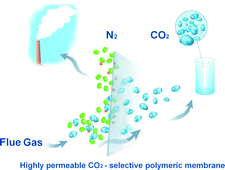Advances in high permeability polymeric membrane materials for CO2 separations
Abstract
Global CO2 emissions have increased steadily in tandem with the use of

- This article is part of the themed collection: Carbon Dioxide
* Corresponding authors
a
Institute for Chemical Process and Environmental Technology, National Research Council Canada, Ottawa, Ontario, Canada
E-mail:
michael.guiver@nrc-cnrc.gc.ca
b WCU Department of Energy Engineering, Hanyang University, Seoul, Republic of Korea
Global CO2 emissions have increased steadily in tandem with the use of

 Please wait while we load your content...
Something went wrong. Try again?
Please wait while we load your content...
Something went wrong. Try again?
N. Du, H. B. Park, M. M. Dal-Cin and M. D. Guiver, Energy Environ. Sci., 2012, 5, 7306 DOI: 10.1039/C1EE02668B
To request permission to reproduce material from this article, please go to the Copyright Clearance Center request page.
If you are an author contributing to an RSC publication, you do not need to request permission provided correct acknowledgement is given.
If you are the author of this article, you do not need to request permission to reproduce figures and diagrams provided correct acknowledgement is given. If you want to reproduce the whole article in a third-party publication (excluding your thesis/dissertation for which permission is not required) please go to the Copyright Clearance Center request page.
Read more about how to correctly acknowledge RSC content.
 Fetching data from CrossRef.
Fetching data from CrossRef.
This may take some time to load.
Loading related content
